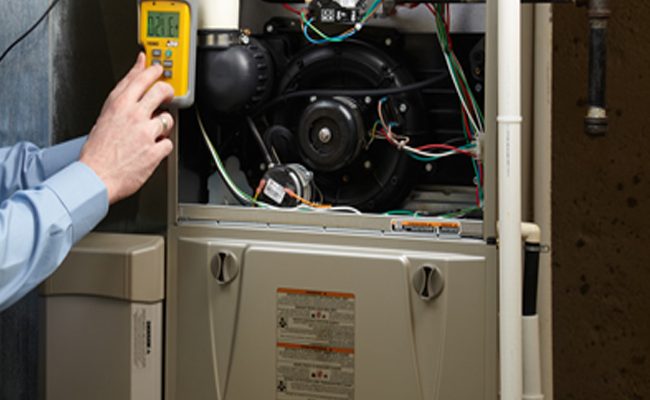
As a homeowner, finding the right spot for your furnace installation is crucial in maintaining an energy-efficient and comfortable living space. One option that has gained popularity recently is installing a furnace in your attic room.
This solution offers various benefits, such as noise reduction and efficient heat distribution, but it also comes with its fair share of downsides like higher installation costs and safety concerns.
In this blog post, we’ll delve into the advantages and disadvantages of installing a furnace in the attic to help you make an informed decision on whether it’s the best choice for your home. Want to install a furnace or heating system? Find more information here.
Key Takeaways
- Installing a furnace upstairs in your attic can save space on lower levels of the house, resulting in quieter operation, and the efficient distribution of air.
- However, homeowners should consider higher installation costs, safety concerns regarding fire hazards and difficult maintenance due to limited accessibility.
- Attic furnaces require additional work for proper ventilation since they are often used for storage rather than living spaces. Electrical wiring may need to be rerouted or added if there isn’t enough power available.
Pros
Installing a furnace upstairs can provide several benefits, such as saving space on lower levels of the house, quieter operation due to distance from living spaces, and improved air distribution throughout the home.
Space-saving
An advantage of installing a furnace in your attic is its space-saving design, which proves to be highly beneficial for homeowners with limited floor area.
For instance, a homeowner who previously had their furnace installed in their basement may find that they now have ample room to create a dedicated laundry area or workout space.
Additionally, attic installations result in shorter ductwork compared to other configurations – maximizing efficiency and minimizing energy loss throughout the heating process.
Quieter operation
Choosing to put your furnace in the attic comes with a huge advantage that it typically operates much quieter than other locations. Since an attic furnace is located further away from the living space, you’ll hear less noise and vibration from its operation.
This is great if your family spends a lot of time on lower levels or if you have bedrooms near where your previous furnace was installed. A quieter unit means less disturbance to sleep or activities taking place around your home.
Better air distribution
One of the main pros of installing a furnace in the attic is enhanced air distribution. As heat rises, having a heating system installed in your attic ensures that heated air can be easily distributed throughout your home’s lower levels through shorter ducts, resulting in improved energy efficiency and reduced electricity costs.
Moreover, installing an attic furnace allows homeowners to clear up valuable storage space on their other floors since there will be no need for bulky traditional furnaces or HVAC systems.
This extra storage space provides additional benefits as it can help keep areas like basements clean and tidy while also reducing clutter from important living spaces.
Cons
While there are pros, this option may come with some cons, including higher installation costs, safety concerns, and difficulties with maintenance.
Higher installation costs
One of the major cons of attic installations is that they can come with higher installation costs. Unlike basement installations, attics require additional work to make space and provide proper ventilation since they are often used for storage rather than living spaces.
This can increase labor and material expenses, which could potentially offset any energy savings from having an attic-mounted furnace. For instance, electrical wiring may need to be rerouted or added if there isn’t enough power available.
Despite these upfront expenses, some homeowners could benefit from investing in an attic furnace due to its long-term cost benefits over traditional HVAC setups. Attic furnaces tend to have shorter ducts compared to conventional setups as they sit closer to where heat is needed most—in lower-level rooms—reducing system inefficiencies and noise pollution caused by air traveling through longer duct runs.
Safety concerns
Although attic furnaces have their benefits, there are some safety concerns that homeowners need to consider. One major concern is the potential for fire hazards due to improper installation or maintenance of the furnace.
Furthermore, accessing an attic furnace for regular maintenance or repairs can also be risky as attics often have narrow access points and require ladders. This can increase the likelihood of accidents from falls or injuries during repairs.
Difficulties with maintenance
One of the major concerns with installing a gas furnace in your attic is the difficulty with maintenance. Since the furnace is located in an area that’s not easily accessible, it can be quite challenging to carry out regular maintenance tasks such as changing air filters and cleaning ducts.
This can lead to a less efficient performance of your HVAC system, which may result in higher electricity costs over time.
Furthermore, addressing any issues with the furnace can also prove to be difficult since you’ll need to climb up into your attic every time there’s a problem. Homeowners who are unable or unwilling to do this themselves will need to hire professionals for repairs or replacement, which could add significant expenses to overall maintenance costs.
Conclusion – Furnace in the attic: Pros and cons
In conclusion, attic furnace installation can have its benefits and drawbacks. It saves space, operates more quietly, and distributes air better. However, it also comes with higher installation costs, possible safety concerns, and difficulties with maintenance.
Homeowners should consider all of these factors before making a decision on an attic furnace installation. It’s wise to make sure that all requirements are met for safe operation and energy efficiency.
Leave a Reply